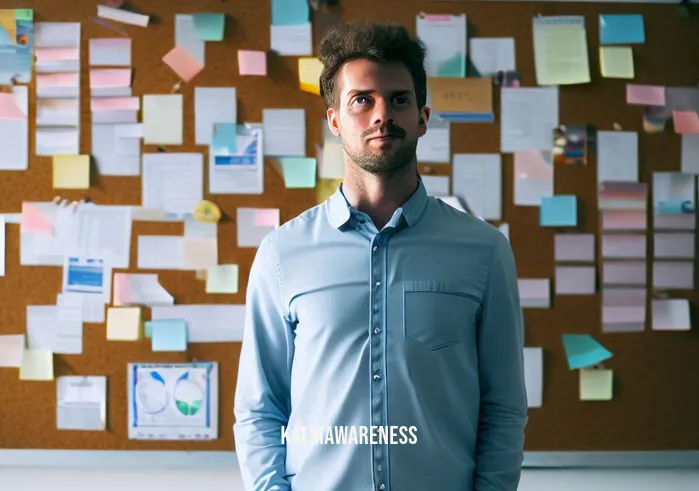Navigating “Into Anguish”: A Journey Through Mindfulness, Body Awareness, and Well-being
The very essence of our being revolves around understanding the mind, body, and soul connection. The delicate balance of these elements often wavers, leading us into anguish. Yet, the very pain we seek to avoid could be the catalyst that propels us towards a holistic understanding of ourselves. This journey we embark upon today will navigate the intricate pathways of mindfulness, body awareness, yoga, breathwork, and self-care, illustrating how they intertwine to foster health and well-being.
The Complex Tapestry of Mindfulness and Anguish
At the heart of understanding anguish is the concept of mindfulness. Mindfulness, as elucidated in Meditation Made Simple, is not just about sitting silently or breathing calmly. It is the art of being completely present in the moment, free from the shackles of past regrets or future anxieties. However, the road to achieving this state is not devoid of its challenges. Delving into a peaceful state of mind where thoughts are not occupied by worry can often seem unattainable.
Why does such a beautiful practice bring about anguish?
This is because, as we start to peel back the layers of our consciousness, we come face-to-face with long-suppressed emotions and thoughts. Judgement of the Wise further explores this dichotomy, shedding light on how the very act of seeking peace can sometimes thrust us into turmoil. Yet, it’s crucial to remember that these are merely stages in our journey, and with continued practice, tranquility awaits.
Embodied Awareness: The Art of Tuning Into Your Body
Embodied awareness or body awareness is the conscious recognition of one’s physical presence. Touch That Body Part discusses how individuals can cultivate a heightened sense of their physical being. This practice encourages individuals to actively engage with and appreciate every aspect of their bodies, from the rhythmic beating of their hearts to the gentle rise and fall of their chests. The more we tune into these sensations, the more connected we feel, alleviating feelings of detachment and desolation that often lead us into anguish.
However, just as with mindfulness, this deep connection with the body might bring to the fore previously unnoticed aches, pains, or discomforts. Instead of shying away, we must learn to embrace these sensations, understanding that they are but messages our bodies are trying to convey.
Yoga and Breathwork: The Symphony of Movement and Stillness
Yoga is often misconceived as mere physical exercise. In truth, it is a spiritual practice that unites the mind, body, and soul. Rouse Yoga dives deep into how this ancient practice helps individuals navigate the tumultuous waters of anguish. By engaging in different postures, individuals learn to release pent-up emotions, making space for peace and tranquility.
Complementing yoga is the practice of breathwork. While it might seem elementary, conscious breathing, as described in How We Get Deep So Fast, has profound effects on our mental and emotional well-being. This element of some meditation exercises teaches us to harness our breath, a tool we have with us always, to center ourselves whenever we’re on the brink of descending into anguish.
The Pillar of Self-Care
“Taking care of yourself doesn’t mean me first; it means me too.”
In our fast-paced world, self-care often takes a backseat. Yet, as Sustainable Self-Care elucidates, it is the cornerstone of mental, emotional, and physical well-being. From indulging in a gratitude meditation before sleep to understanding the profound spiritual benefits of mirror gazing, self-care is a vast realm that offers numerous tools to combat anguish.
As we conclude this introductory segment, remember that the journey into anguish is not a descent into hopelessness. It’s an invitation to understand oneself better, to harness the powerful tools of mindfulness, body awareness, yoga, breathwork, and self-care. With each step, we come closer to attaining a state of equilibrium, where anguish is merely a visitor, not a resident.
For a deeper dive into these practices and their transformative power, continue reading in the next segment.

Exploring the Depths: Understanding the Nuances of “Into Anguish”
The concept of “into anguish” is multifaceted, encompassing a range of emotions, triggers, and responses. At its core, it describes a profound emotional state of distress or unease, often stemming from a multitude of factors. To better grasp its complexities and how we can navigate through it, it’s crucial to delve deeper into its many facets.
Emotions Entwined with “Into Anguish”
Diving into anguish often brings with it a cascade of associated emotions. Some of these include:
- Desolation: A profound sense of loneliness or abandonment.
- Despair: A loss of hope, often feeling insurmountable.
- Frustration: A sense of stagnation or inability to move forward.
- Overwhelm: A flood of too many emotions or stimuli at once.
- Anxiety: Persistent worry about future events or past actions.
Understanding these emotions is the first step in recognizing when we are spiraling into anguish and determining actionable steps to pull ourselves out.
Potential Triggers of Anguish
Various life events or situations can act as triggers, pushing one into a state of anguish. Pretty Soon, Meaning expounds on how fleeting moments or significant life changes can have lasting emotional impacts. A few common triggers include:
- Personal Loss: Whether it’s the death of a loved one, a broken relationship, or loss of a job.
- Health Issues: Chronic pain, terminal illnesses, or unexpected health crises.
- Financial Stress: Debt, unemployment, or unforeseen expenses.
- Traumatic Events: Accidents, natural disasters, or any form of abuse.
- Personal Failures: Not meeting personal expectations or perceived shortcomings.
It’s essential to be mindful of these triggers, not just in our lives but in the lives of those around us. Recognizing a potential source of anguish can empower us to seek help or offer support.
Mitigating the Impact: Strategies to Navigate Through Anguish
To transform our relationship with anguish, we must have an arsenal of strategies at our disposal. The table below offers a snapshot of effective techniques, paired with resources that provide a deeper understanding:
| Strategy | Description | Resource Link |
|---|---|---|
| Meditation | A practice to center the mind, promoting peace and clarity. | Can U Meditate Lying Down? |
| Journaling | Writing down feelings to process and understand them better. | One for Each Blessed Day |
| Professional Counseling | Seeking help from trained professionals to navigate emotional turmoil. | Train Your Mind to be Stronger Than Your Feelings |
| Physical Activity | Engaging in exercises, like walking, to release pent-up emotions. | Teenagers Walking |
| Mindful Hypnobirthing | A technique primarily for expecting mothers, promoting calmness and control during childbirth. | Mindful Hypnobirthing |
Implementing even one of these strategies can pave the way for healing, offering a lifeline when one feels pulled into the depths of anguish.
Anguish: A Catalyst for Growth
While the journey into anguish is undeniably painful, it’s crucial to view it not as a life sentence but as an opportunity. History and personal stories abound with tales of individuals who, after plunging into depths of despair, emerged stronger, wiser, and more resilient. As Jack Kornfield’s Meditation for Beginners suggests, these moments of intense emotion can be pivotal in our personal growth journey, prompting introspection, compassion, and evolution.
In the face of anguish, it’s easy to feel isolated, believing that no one else could possibly understand our pain. Yet, by shedding light on its intricacies, by unraveling its triggers, emotions, and potential coping strategies, we begin to demystify it, turning it from an overpowering monster into a challenge we can confront and overcome.
As we journey forward, the next chapter will delve deeper into actionable steps and holistic approaches to not just cope with anguish but to transform our relationship with it. Stay with us as we continue to illuminate this path, offering hope and healing every step of the way.

A Ray of Light: Unearthing Hope in the Midst of Anguish
The phrase “into anguish” often brings about images of desolation and despair. Yet, within its cavernous depths lies a potential treasure: the prospect of inspiration and resurgence. As we embark on this chapter, let’s journey through tales of triumph over tribulation and uncover the radiant glimmers of hope that have emerged from the darkest moments.
Voices of Hope: Inspiring Quotes in the Face of Despair
Throughout history, many have faced anguish, despair, and hopelessness. Yet, from these depths, some of the most profound wisdom has emerged:
- “Out of suffering have emerged the strongest souls; the most massive characters are seared with scars.” — Khalil Gibran
- “The gem cannot be polished without friction, nor man perfected without trials.” — Chinese Proverb
- “Believe in yourself and all that you are. Know that there is something inside you that is greater than any obstacle.” — Christian D. Larson
- “Every adversity, every failure, every heartache carries with it the seed of an equal or greater benefit.” — Napoleon Hill
- “What the caterpillar calls the end of the world, the master calls a butterfly.” — Richard Bach
These quotes serve as powerful reminders that pain, as intense as it may feel, often precedes personal evolution, growth, and enlightenment.
Real-Life Resurgence: Stories that Illuminate the Path
Sarah’s Journey with Mindful Movement Sleep: Sarah experienced a debilitating accident that left her bedridden for months. The despair of not being mobile pushed her deep into anguish. However, through mindful movement practices focusing on restful sleep, she gradually regained strength, both physically and mentally. Her story is a testament to the power of the mind-body connection.
Michael’s Realization Through Mirror Gazing’s Spiritual Benefits: In the aftermath of a painful breakup, Michael felt lost and bereft of self-worth. Through the practice of mirror gazing, he began to see himself beyond the pain, recognizing his inherent worth and strength. This reflective exercise became a pivotal turning point, guiding him from overwhelming despair to self-compassion and understanding.
Emma’s Path with Sustainable Self-Care: Emma, a frontline worker during a global crisis, was constantly submerged in an environment of stress and sorrow. The weight of her responsibilities and the tragedies she witnessed daily pushed her to the brink of burnout. Discovering the concept of sustainable self-care, she learned to integrate restorative practices into her daily life, ensuring that she could continue her invaluable work without succumbing to its emotional toll.
These individuals, facing immense challenges, found paths to healing and resilience. Their stories emphasize that, even when plunged deep into anguish, there’s always a way out, a spark of hope, and the potential for a brighter tomorrow.
The Infinite Power of Perspective
A common thread among these stories is a shift in perspective. Viewing anguish not as a life sentence but as a temporary phase can make a world of difference. As Element of Some Meditation Exercises elaborates, the power of perspective is monumental. Recognizing that pain is just one element of our vast emotional landscape allows us to integrate it rather than be defined by it.
Gazing Ahead: The Journey Continues
While this chapter has shed light on the inspirational tales of those who’ve faced and overcome anguish, our journey is far from over. As we move forward, the subsequent segment will focus on concrete methods and techniques to actively combat and overcome anguish. These approaches, rooted in ancient wisdom and modern science alike, offer tangible solutions for those seeking relief and solace.
Join us in the next chapter as we delve into actionable strategies, ensuring that no matter how deep the pain, there’s always a path to healing and hope.

The Anatomy of Anguish: Understanding its Depths
The journey into anguish is akin to plunging into the ocean; it is vast, sometimes overwhelming, and can often feel all-encompassing. Yet, like any complex experience, breaking it down into comprehensible segments makes it more manageable. This chapter will dissect the many facets of anguish, utilizing bullet points and lists to provide clarity and deeper understanding.
Root Causes: Unveiling the Origins of Anguish
Understanding where anguish stems from is the first step in addressing and ultimately overcoming it. Here are some common causes:
- Personal Loss: Whether it’s the death of a loved one, end of a relationship, or loss of a job, personal losses can profoundly affect our emotional state.
- Traumatic Events: Incidents like accidents, violent encounters, or natural disasters can induce long-term psychological distress.
- Chronic Illness: Living with persistent health conditions can lead to feelings of despair and hopelessness.
- Mental Health Disorders: Conditions like depression, anxiety, or bipolar disorder can inherently include episodes of anguish.
- Existential Crisis: Moments of introspection about life’s meaning and purpose can sometimes lead to feelings of anguish.
Physical Manifestations: How Our Body Reacts
Anguish isn’t solely a mental or emotional state; it often has physical repercussions. Some of these include:
- Sleep Disturbances: From Mindful Movement Sleep, we understand that emotional distress can affect our sleep patterns, leading to insomnia or oversleeping.
- Appetite Changes: Either a loss of appetite or overeating as a coping mechanism.
- Fatigue: Feeling constantly tired or drained, even after adequate rest.
- Muscle Tension: Physical tightness, especially in the shoulders, neck, or back.
- Digestive Issues: Such as stomachaches, constipation, or diarrhea.
Mental and Emotional Responses
Our psyche has its way of grappling with anguish. Some reactions might include:
- Rumination: Constantly thinking about the distressing event or circumstance.
- Avoidance: Evading places, people, or activities that are reminders of the pain.
- Numbness: Feeling emotionally detached or indifferent.
- Irritability: Easily getting angered or frustrated.
- Despair: A pervasive sense of hopelessness or thinking things will never get better.
Coping Mechanisms: The Healthy and the Harmful
When plunged into anguish, individuals often resort to various means to alleviate the pain. These can range from beneficial practices to detrimental habits:
- Healthy Mechanisms:
- Engaging in Gratitude Meditation Before Sleep to shift focus from pain to positivity.
- Practicing Mindful Hypnobirthing for expecting mothers to ease childbirth-related anxieties.
- Seeking therapy or counseling for professional guidance.
- Harmful Mechanisms:
- Substance abuse.
- Overworking or total withdrawal from responsibilities.
- Engaging in high-risk behaviors without considering consequences.
A Glimpse into the Horizon: A Prelude to Solutions
Having traversed the vast landscape of anguish, we now stand at the cusp of discovering solutions. While understanding the intricacies of this emotion is essential, our ultimate aim is to find ways to navigate, cope, and perhaps even transcend it.
In our concluding chapter, we will explore a holistic approach to managing anguish. Rooted in ancient wisdom, modern science, and real-life testimonies, these strategies promise hope and healing. Join us in the final chapter, where we not only understand anguish but learn to rise above it.

Charting a Path Beyond Anguish: The Journey Concludes
As we find ourselves at the culmination of our in-depth exploration into anguish, let us reflect on the terrain we’ve traversed and gaze optimistically toward the horizon. The ripples of anguish, though tumultuous, have led us to richer shores of understanding and compassion.
A Recap: Anguish Dissected and Understood
From the onset, our mission was clear: to understand the intricate fabric of anguish and its profound impact on the human psyche. And what a journey it’s been! From its roots and causes to its manifestations in our physical and emotional realms, we’ve journeyed through the highs and lows of this intense emotion.
With insights from how to attain a peaceful state of mind, we’ve unearthed coping mechanisms both beneficial and detrimental. We’ve also delved deep into practices, such as mirror gazing and its spiritual benefits, which offer respite and guidance.
The Silver Lining: Hope Amidst Despair
In every cloud of anguish, there’s a silver lining waiting to be discovered. It’s crucial to remember that emotions, no matter how overwhelming, are transient. They ebb and flow, offering us valuable lessons in resilience and adaptability. With tools like meditation made simple and practices fostering sustainable self-care, we have the means to navigate through the stormiest of emotional seas.
Your Next Steps: Knowledge Applied
Armed with this newfound understanding, the real challenge (and opportunity) lies in its application. Engage in introspection. Revisit past chapters to consolidate your knowledge. Explore our other content pieces, like Jack Kornfield’s meditation for beginners, to further empower your journey.
A Heartfelt Thank You
To our cherished readers, thank you for embarking on this journey with us. Your curiosity and quest for knowledge fuel our endeavors. Rest assured, the pages of our magazine will always strive to illuminate the myriad complexities of the human experience, ensuring you’re never alone in your journey.
As we conclude this segment on anguish, remember: every end is a new beginning. Stay curious, stay compassionate, and most importantly, always stay connected to yourself and the world around you. For more enlightening journeys, explorations, and insights, keep turning our pages. The adventure never truly ends; it merely takes new forms.





